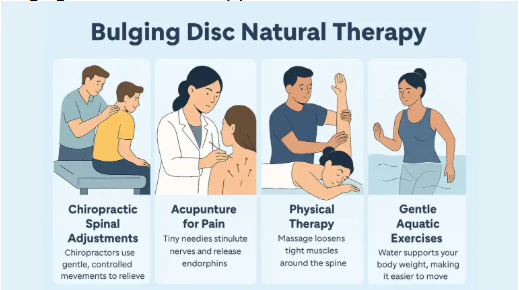A bulging disc happens when the soft cushion between your vertebrae shifts out of place. This may lead to back pain, stiffness, or nerve symptoms. Many people worry that only surgery can fix it, but most bulging discs heal naturally with the right care.
In this article, you will learn how to heal a bulging disc naturally, including stretches, home remedies, posture corrections, daily habits, and when to seek medical help.
Understanding a Bulging Disc
Your spine has soft discs that act as shock absorbers. When one of these discs bulges outward, it may press on nearby nerves. This can cause pain in your back, hips, or legs.
Natural healing is possible because discs respond well to movement, hydration, and controlled pressure. The right stretches and habits support this healing process.
Common Symptoms of a Bulging Disc
You may feel dull or sharp back pain. Tingling, numbness, or muscle weakness can occur if nerves are compressed. Pain may worsen when sitting, bending, or lifting heavy objects. Recognizing your symptoms helps you choose the right relief techniques.
Causes of a Bulging Disc
Poor posture, lifting incorrectly, sudden injuries, weak core muscles, aging, or sitting too long can strain your spine. Repeated pressure on your discs can cause them to bulge over time. Understanding these causes helps you prevent future flare-ups.
How to Heal a Bulging Disc Naturally
Gentle Stretches for Disc Relief
Stretches promote blood flow, reduce pressure, and support your spine. Practice them slowly and stop if pain increases.
Cat-Cow Stretch
Move between arching and rounding your spine. This increases mobility and reduces stiffness.
Child’s Pose
This stretch relaxes your lower back muscles. Hold it for 20–30 seconds while breathing deeply.
Cobra Stretch
Lie on your stomach and lift your chest gently. This encourages the disc to shift away from nerves.
Knee-to-Chest Stretch
Pull one knee at a time to your chest. This reduces lower back tension.
Strengthening Exercises for Support
Strengthening muscles around your spine helps stabilize the area.
Pelvic Tilts
Tilt your pelvis forward and backward while lying on your back. This activates your core and improves spinal alignment.
Bridge Exercise
Lift your hips slowly. This strengthens your glutes and supports the lower back.
Core Bracing
Tighten your abdominal muscles for a few seconds while breathing normally. This protects your spine during daily movements.
Posture Correction and Spinal Alignment
Poor posture puts pressure on your discs. Align your ears, shoulders, and hips when standing or sitting. Keep your back supported with a cushion if you sit for long periods.
When lifting objects, bend your knees, not your back. Hold heavy items close to your body to reduce strain.
Heat and Cold Therapy
Cold packs reduce swelling and numb sharp pain. Heat improves blood flow and relaxes tight muscles. Use cold for new pain and heat for stiffness. Alternate both for balanced relief.
Anti-Inflammatory Foods and Hydration
A bulging disc heals faster when inflammation is reduced. Include turmeric, ginger, green leafy vegetables, berries, and omega-3-rich foods in your diet.
Drink enough water to keep your discs hydrated. Proper hydration maintains disc height and flexibility.
Natural Pain Relief Options
Epsom salt baths relax muscles and reduce inflammation. Essential oils like peppermint or lavender offer soothing effects. Gentle massage improves circulation and relieves pressure around the spine.
Improving Daily Habits for Faster Healing
Avoid long sitting sessions. Take breaks every 30–45 minutes to stretch or walk. Use a supportive chair or stand intermittently during work.
Sleep on your back or side with a pillow between your knees. Avoid sleeping on your stomach since it strains your spine.
When to Seek Medical Help
Seek medical attention if pain spreads to your legs, causes weakness, or affects bladder or bowel control. Severe or worsening symptoms may require imaging tests or specialist care. Early diagnosis helps prevent complications.
Long-Term Prevention Strategies
Keep your core strong with regular exercise. Practice good posture daily. Stay active with walking, swimming, or low-impact workouts. Maintain a healthy weight to reduce pressure on your discs. These habits support long-term spinal health.
Frequently Asked Questions
1. Can a bulging disc heal naturally?
Yes. Most bulging discs improve with rest, stretches, and posture correction.
2. How long does natural healing take?
It may take a few weeks to a few months, depending on severity and consistency of care.
3. What is the fastest natural way to reduce pain?
Gentle stretching, heat and cold therapy, and core support techniques offer quick relief.
4. Can walking help a bulging disc?
Yes. Walking improves circulation and reduces spinal pressure.
5. Should you stretch every day?
Yes. Daily stretching supports mobility and reduces muscle tension.
6. Is heat or ice better for a bulging disc?
Use ice for new pain and heat for stiffness. Alternating both works well.
7. Can sleeping positions affect healing?
Yes. Back or side sleeping supports alignment and reduces pressure on your disc.
8. Do I need surgery for a bulging disc?
Most cases do not need surgery. Natural methods often work effectively.
9. Can diet help reduce inflammation?
Yes. Foods rich in antioxidants and omega-3s support healing and lower inflammation.
10. When should I see a doctor?
Seek help if pain worsens, spreads, or affects your bladder or bowel function.

